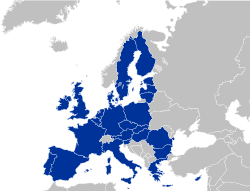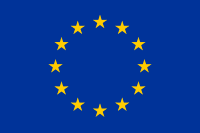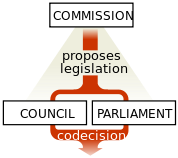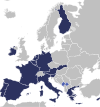European Atomic Energy Community
|
European Atomic Energy Community
|
||||
|---|---|---|---|---|
|
||||
 Current membership of Euratom; coinciding with that of the European Union
|
||||
| Administrative center | Brussels, Belgium | |||
| Official languages | 23 | |||
| Type | International Organisation | |||
| Membership | 27 EU Members | |||
| Establishment | 1958 | |||
| - | Treaty of Rome | 1 January 1958 | ||
| - | Merger Treaty | 1 July 1967 | ||
| Fully controlled by the European Union | ||||
The European Atomic Energy Community (EAEC or Euratom) is an international organisation which is legally distinct from the European Union (EU), but has the same membership, and is governed by the EU's institutions.
It was established on 25 March 1957 along with the European Economic Community (EEC) by the Treaty of Rome, being taken over by the executive institutions of the EEC in 1967. Even though the other communities were merged together in 1993 and 2009, the community has maintained a legally distinct nature from the European Union.
Contents |
History
The Common Assembly proposed extending the powers of the European Coal and Steel Community to cover other sources of energy. However Jean Monnet, ECSC architect and President, desired a separate community to cover nuclear power. Louis Armand was put in charge of a study into the prospects of nuclear energy use in Europe, his report concluded that further nuclear development was needed to fill the deficit left by the exhaustion of coal deposits and to reduce dependence on oil producers. However the Benelux states and Germany were also keen on creating a general common market, although it was opposed by France due to its protectionism and Jean Monnet thought it too large and difficult a task. In the end, Monnet proposed the creation of separate atomic energy and economic communities, to reconcile both groups.[1]
The Intergovernmental Conference on the Common Market and Euratom at Val Duchesse in 1956 drew up the essentials of the new treaties. Euratom would foster co-operation in the nuclear field, at the time a very popular area, and would, along with the EEC, share the Common Assembly and Court of Justice of the ECSC, but not its executives. Euratom would have its own Commission, with fewer powers than the ECSC's High Authority, and Council. On 25 March 1957, the Treaties of Rome were signed by the ECSC members and on 1 January 1958 they came into force.[2][3][4]
To save on resources, these separate executives created by the Rome Treaties were merged in 1965 by the Merger Treaty. The institutions of the EEC would take over responsibilities for the running of the EEC and Euratom, with all three then becoming known as the European Communities although each legally existed separately. In 1993, the Maastricht Treaty created the European Union, which absorbed the Communities into the European Community pillar, yet Euratom still maintains a distinct legal personality and the treaty remains in force relatively un-amended from its original signing.
The European Constitution was intended to consolidate all previous treaties and increase democratic accountability in them. The Euratom had not been amended in the same way the other treaties had and hence the European Parliament had been granted few powers of it. However, the reason it had gone unamended was the same reason the Constitution left it to remain separate from the rest of the EU: anti-nuclear sentiment among the European electorate which may unnecessarily turn voters against the treaty.[5][6][7]
| Signed In force Document |
1948 1948 Brussels Treaty |
1951 1952 Paris Treaty |
1954 1955 Modified Brussels Treaty |
1957 1958 Rome Treaties |
1965 1967 Merger Treaty |
1975 N/A European Council conclusion |
1986 1987 Single European Act |
1992 1993 Maastricht Treaty |
1997 1999 Amsterdam Treaty |
2001 2003 Nice Treaty |
2007 2009 Lisbon Treaty |
||||||||||
| Three pillars of the European Union: | |||||||||||||||||||||
| European Communities: | |||||||||||||||||||||
| European Atomic Energy Community (EURATOM) | |||||||||||||||||||||
| European Coal and Steel Community (ECSC) | Treaty expired in 2002 | European Union (EU) | |||||||||||||||||||
| European Economic Community (EEC) | European Community (EC) | ||||||||||||||||||||
| TREVI | Justice and Home Affairs (JHA) | ||||||||||||||||||||
| Police and Judicial Co-operation in Criminal Matters (PJCC) | |||||||||||||||||||||
| European Political Cooperation (EPC) | Common Foreign and Security Policy (CFSP) | ||||||||||||||||||||
| Unconsolidated bodies | Western European Union (WEU) | ||||||||||||||||||||
| Treaty terminated in 2010 | |||||||||||||||||||||
| European Union |
 This article is part of the series: |
|
Policies and issues
|
|
Foreign relations
|
Aims and achievements
The purposes of Euratom are to create a specialist market for nuclear power and distribute it through the Community and to develop nuclear energy and sell surplus to non-Community States. Its major project is currently its participation in the international fusion reactor ITER [8] financed under the nuclear part of FP7. Euratom also provides a mechanism for providing loans to finance nuclear projects in the EU.
In the history of European regulation, Article 37 of the Euratom Treaty represents pioneering legislation concerning binding transfrontier obligations with respect to environmental impact and protection of humans.[9]
Presidents of the EAEC
The five member Commission was led by only three Presidents while it had independent executives (1958-1967), all from France;
- Louis Armand (France) 1958-1959 - Armand Commission
- Étienne Hirsch (France) 1959-1962- Hirsch Commission
- Pierre Chatenet (France) 1962-1967- Chatenet Commission
See also
- Institutions of the European Union
- History of the European Union
- EU Directorate General Joint Research Centre - often incorrectly referred to as Euratom due to EURATOM being its origin.
- Energy Community
- Energy policy of the European Union
- Nuclear energy in the European Union
- The nuclear part of the The Seventh Framework Programme for research and technological development, the European Union's chief instrument for funding research.
References
- ↑ 1957-1968 Successes and crises European NAvigator
- ↑ A European Atomic Energy Community European NAvigator
- ↑ The signing of the Rome Treaties ENA
- ↑ Drafting of the Rome Treaties European NAvigator
- ↑ Euratom: nuking Europe's future | Greenpeace International
- ↑ Declaration_abolish_EURATOM
- ↑ Euratom reform
- ↑ Fusion for Energy - Homepage
- ↑ Heuel-Fabianek, B., Kümmerle, E., Möllmann-Coers, M., Lennartz, R. (2008): The relevance of Article 37 of the Euratom Treaty for the dismantling of nuclear reactors. atw - International Journal for Nuclear Power 6/2008
External links
- European Atomic Energy Community website
- Treaty establishing the European Atomic Energy Community (EURATOM)
- History of the Rome Treaties European NAvigator
- European Commission Fusion Research
- European Commission Fission Research
|
||||||||||||||||||||||||||||||||||||||||||






